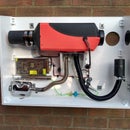Introduction: Myford ML10 Lathe Oil Nipple Socket for Cone Pulley Lubrication
I'm unhappy with the performance of my oil gun when lubricating the cone pulley on my Myford ML10 lathe. Oil seems to go everywhere, except into the nipple.
I wanted to remove the nipple, and see whether there was oil inside, or perhaps do the oiling by 'injecting' oil into the bearing with a 'normal' oil can.
Removing the nipple is not easy because it is recessed so much. Spanners are very hard to use, I didn't have a box spanner, normal sockets are too bulky to fit over the flats on the nipple due to the cone pulley.
This short Instructable, just shows the way I adapted an electric drill extension rod, to do the job.
Lubrication is only necessary when the back gears are in use - the cone pulley and its attached brass gear then spin around on the steel spindle and need lubricating (every half hour of use). Under normal turning, lubricating this nipple is not necessary. This is an OIL nipple for use with ISO32 oil.
Step 1: Hex Shank Screwdriver Extension Rod
I had a 1/4" hex shank extension rod, which I never used. The 1/4" hex socket is the perfect fit for the oil nipple.
However the rod cannot be used 'as is' because it does not clear the pulley itself or the bull wheel gear.
Removing the sleeve makes it possible to fit the socket over the nipple, but the alignment is still wrong, because the rod is too wide and fouls on the bull wheel.
Step 2: Custom Made Nipple Removal Tool
The solution was easy, and can be seen in the photographs. A quick bit of turning, slimmed down the rod at the point it fouled on the bull gear.
The extension rod was a magnetic variety, so the nipple does not fall out into the guts of the machine when it is unscrewed. The socket was a little deep, so the nipple retracted right inside, but I dropped a 1/4" nut inside (it stays permanently there by magnetism) which means that the nipple sits in the socket with a few threads visible - just right for screwing back on.
The nipple is now easy to remove and replace.
The oil can now be seen inside the bearing housing - quite reassuring. I'm not sure whether I will lubricate it using this method in future.













